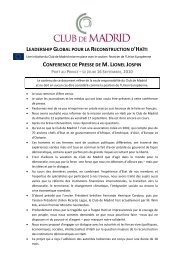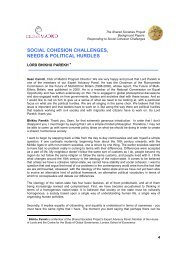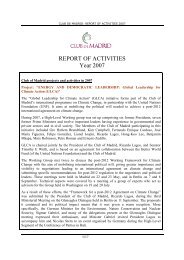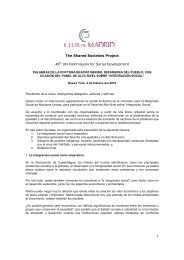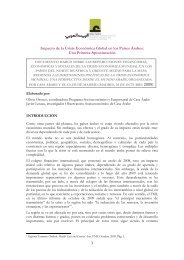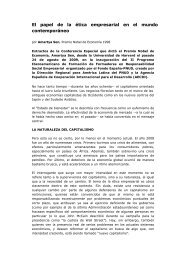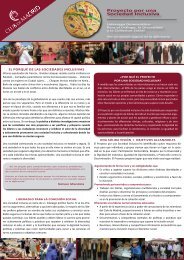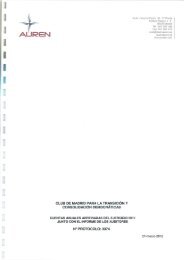Investing cultural diversity and intercultural dialogue - Business and ...
Investing cultural diversity and intercultural dialogue - Business and ...
Investing cultural diversity and intercultural dialogue - Business and ...
You also want an ePaper? Increase the reach of your titles
YUMPU automatically turns print PDFs into web optimized ePapers that Google loves.
12 . PART II – KEY VECTORS OF CULTURAL DIVERSITY<br />
<strong>and</strong> often contradictory. In many instances, transfer away<br />
from minority languages is not towards English but<br />
towards other rival languages <strong>and</strong> regional dialects,<br />
suggesting that the widespread use of English may be<br />
limited to specific purposes, such as transactions <strong>and</strong><br />
functional communication. Globalization has also<br />
encouraged more plural <strong>and</strong> hybrid approaches to<br />
English, revealing the highly complex ways in which<br />
language, identity <strong>and</strong> relationships interact <strong>and</strong> how<br />
speakers adapt inherited forms of language to new<br />
<strong>cultural</strong> contexts <strong>and</strong> for new purposes.<br />
L Storyteller speaking to a<br />
crowd in Jemaa el-Fna<br />
Square in Marrakesh,<br />
Morocco<br />
I Epic storyteller,<br />
Kyrgyzstan<br />
Chapter 3: Languages<br />
Languages mediate our experiences, our intellectual<br />
<strong>and</strong> <strong>cultural</strong> environments, our modes of encounter<br />
with human groups, our value systems, social codes <strong>and</strong><br />
sense of belonging, both collectively <strong>and</strong> personally.<br />
From the perspective of <strong>cultural</strong> <strong>diversity</strong>, linguistic<br />
<strong>diversity</strong> reflects the creative adaptation of human<br />
groups to their changing physical <strong>and</strong> social<br />
environments. In this sense, languages are not just a<br />
means of communication but represent the very fabric<br />
of <strong>cultural</strong> expressions, the carriers of identity, values<br />
<strong>and</strong> worldviews.<br />
Language dynamics today<br />
Linguists believe that a large percentage of the<br />
world’s languages is likely to disappear in the course<br />
of this century. Half of the languages in existence<br />
today – estimated at between 6,000 <strong>and</strong> 8,000 – are<br />
spoken by less than 10,000 people, <strong>and</strong> one such<br />
language is said to disappear every two weeks. While<br />
the growth of vehicular languages (English in<br />
particular) associated with globalization processes is<br />
having major impacts on languages worldwide,<br />
languages shift in response to myriad political, social,<br />
economic <strong>and</strong> <strong>cultural</strong> conditions, <strong>and</strong> the effects of<br />
globalization on linguistic <strong>diversity</strong> are far from simple<br />
Through migration, colonial expansion, refugee<br />
displacement or professional mobility, many language<br />
communities are now dispersed across the world. As<br />
connections between language <strong>and</strong> place become<br />
increasingly multiple, communication patterns are<br />
becoming highly variegated, characterized by codeswitching,<br />
multilingualism, different receptive <strong>and</strong><br />
productive competencies in different languages or<br />
dialects, <strong>and</strong> are marked by mixtures of full, partial <strong>and</strong><br />
specialized proficiencies. In this way, continuously<br />
exp<strong>and</strong>ing networks – based on mobile phones,<br />
broadb<strong>and</strong> Internet <strong>and</strong> other information <strong>and</strong><br />
communication technologies (ICTs) – are creating new<br />
forms of human association of unprecedented scale <strong>and</strong><br />
flexibility, spanning cities, nations <strong>and</strong> cultures. These are<br />
in turn forging new linguistic forms <strong>and</strong> practices linked<br />
to new <strong>cultural</strong> identities that are broadening, <strong>and</strong><br />
redefining, existing boundaries across public/private<br />
domains <strong>and</strong> social, <strong>cultural</strong> <strong>and</strong> educational contexts.



